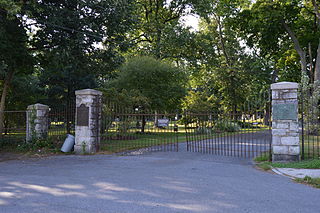Related Research Articles

Crawford County is a county in the Commonwealth of Pennsylvania. As of the 2020 census, the population was 83,938. Its county seat is Meadville. The county was created on March 12, 1800, from part of Allegheny County and named for Colonel William Crawford.

Meadville is a city in and the county seat of Crawford County, Pennsylvania, United States. The population was 13,050 at the 2020 census. The first permanent settlement in Northwestern Pennsylvania, Meadville is within 40 miles (64 km) of Erie and within 90 miles (140 km) of Pittsburgh. It is the principal city of the Meadville micropolitan area, as well as part of the larger Erie–Meadville combined statistical area.

A zipper, zip, fly, or zip fastener, formerly known as a clasp locker, is a commonly used device for binding together two edges of fabric or other flexible material. Used in clothing, luggage and other bags, camping gear, and many other items, zippers come in a wide range of sizes, shapes, and colors. Whitcomb L. Judson, an American inventor from Chicago, in 1892 patented the original design from which the modern device evolved.

Gideon Sundback was a Swedish-American electrical engineer, who is most commonly associated with his work in the development of the zipper.

John Dick was an American politician and judge. He represented Pennsylvania as a Whig, a member of the Opposition Party and a Republican in the United States House of Representatives.

Arthur Laban Bates was a Republican member of the United States House of Representatives from the state of Pennsylvania.

Athelston Gaston was a Democratic member of the U.S. House of Representatives from Pennsylvania.

Samuel Penniman Bates (1827–1902) was an American educator, author, and historian. He is known for his reference works on the American Civil War, including his multi-volume History of Pennsylvania Volunteers, 1861–1865 which remains a frequently-used, preliminary research resource due to its narrative descriptions of unit activities and rosters of the regiments raised in the Commonwealth of Pennsylvania.

Samuel Bernard Dick was an American politician who served as a Republican member of the U.S. House of Representatives from Pennsylvania from 1879 to 1881.

Hiram Lawton Richmond was a Republican member of the U.S. House of Representatives from Pennsylvania.

Solomon Newton Pettis was a Republican member of the U.S. House of Representatives from Pennsylvania.
Darwin Asahel Finney was a Republican member of the U.S. House of Representatives from Pennsylvania.
Abraham Robinson McIlvaine was a Whig member of the U.S. House of Representatives from Pennsylvania.
John W. Howe was a Free Soil and Whig member of the U.S. House of Representatives from Pennsylvania.
John Wilson Farrelly was an American politician from Pennsylvania who served as a Whig member of the U.S. House of Representatives for Pennsylvania's 22nd congressional district from 1847 to 1849.
Patrick Farrelly was a member of the U.S. House of Representatives from Pennsylvania.
Stephen Barlow was a Jacksonian member of the U.S. House of Representatives from Pennsylvania.
Thomas Hale Sill was a Jacksonian and National Republican member of the U.S. House of Representatives from Pennsylvania.

Harrisburg Cemetery, sometimes referred to as Mount Kalmia Cemetery, is a prominent rural cemetery and national historic district in Harrisburg, Pennsylvania, located at 13th and Liberty streets in the Allison Hill/East Harrisburg neighborhoods of the city. It was officially founded in 1845, although interments took place for many years before. The cemetery is also the burial ground for American Revolutionary War soldiers. The caretaker's cottage was built in 1850. It was designed by famed 19th Century architect, Andrew Jackson Downing, in the Gothic Revival style.
Major General David Mead was an American military general and founder of Meadville, Pennsylvania.
References
- ↑ Moore, William B.; Rekas, Elizabeth H. (2012). Meadville. Arcadia Publishing p. 59. ISBN 978-0-7385-9781-2.
- ↑ Drumm, Lorri (May 19, 2017). "Greendale Cemetery rhododendrons almost at peak". The Meadville Tribune . Retrieved February 17, 2019.
- ↑ Spicer, Mary (October 8, 2008). "Lantern tours to reveal ghostly past of Greendale Cemetery". The Meadville Tribune . Retrieved February 17, 2019.
- ↑ "Gideon Sundback celebrated in a Google doodle". The Guardian . April 23, 2012. Retrieved February 17, 2019.